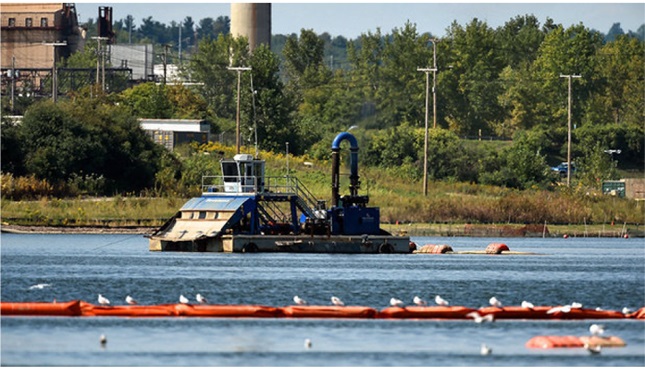HYDRAULIC SLURRY PLACEMENT
Direct Powdered AC Placement
A unique method for direct-placement of powdered AC was done for the Trondheim Harbor, Norway pilot project. The conceptual design and details of the placement methods are in the report Sediment remediation through activated carbon amendment Long-term monitoring of a field pilot in Trondheim Harbour. Five experimental field plots were established: (1) a reference site with no capping, (2) a plot capped with AC only, (3) a plot with AC mixed with bentonite clay, (4) a plot with AC and then covered by a thin-layer (5 mm) of sand, and (5) a plot with a thin-layer of sand (5 mm) as a control.
The inclusion of the AC + bentonite clay was a unique approach that was intended to
- create a viscous slurry to facilitate placement
- maintain the AC in place, (i.e. protect it from lateral advection and increase the longevity of the capping treatment (tidal current up to 20 cm s-1) and
- to provide a more natural and viable substrate to the benthic fauna.
The purpose of the sand capping over the AC was also to protect the AC from erosion.
To further facilitate placement and AC particle settling, the AC was mixed with a 10% w/w NaCl solution in a cement blender (AC:water 1:3 v/v; 10 min) on a pontoon in the harbor (Cornelissen et al 2011). The purpose of the salt was to saturate the AC pore system with water that was slightly heavier than surrounding water. For the AC-only and AC+sand fields, this slurry was pumped out with a flexible manually operated hose (inner diameter 5 cm) that was moved evenly above the area of the seafloor to be covered by the particular amount of AC in the blender. The slurry was released approximately one meter above the sediment bed at a rate of 20 L/min. For the AC+clay plots, AC and bentonite clay (dry powdered white sodium montmorillonite clay, mean particle size 3 µm; pH 8.5; density 2.6 kg/m3) were mixed 1:1:6 with 10%-NaCl solution and pumped out as described above. For the AC+sand fields, a 5-mm thick sand cap (particle size 0-1 mm construction sand) was placed on top of the AC cap, 24 h after placing the AC, by spraying the dry sand under the water surface using sand blasting equipment.
Hydraulic Placement of a GAC+Sand Cap
As part of the Onondaga Lake NY sediment remediation, application of a GAC+sand layer was done by formulating on-land a hydraulic slurry of the material, and then pumping the slurry to a custom-built spreader barge on the lake. A summary of that placement system based on the Onondaga Lake Capping Field Demonstration Work Plan and the Capping Field Demonstration Summary Report is given below.
The land-based portion of the system was comprised of an upland hopper, loaded by an excavator that fed sand from a stockpile to a slurry mix tank. The slurry mix tank mixed the sand with water from the lake. GAC in the size range of 0.3 - 2.0 mm (#50 to #10 sieve size) was separately mixed and pumped to the discharge of the sand slurry mix tank and introduced into the discharge pipe of sand slurry to create the sand and GAC slurry mix.
The GAC was mixed with water prior to placement in order to saturate the void space of the GAC (i.e. removing entrained air) to promote more rapid settling through the water column during placement. Subsequently the mixed sand/GAC slurry was pumped by a booster pump through a HDPE pipeline to the spreader barge at the demonstration location.
The spreader barge was equipped with a diffuser plate that reduced the energy of the hydraulic slurry of the capping materials. The spreader barge had a hydraulic cable winch system and anchors to facilitate the movement of the barge for placement of the material. Using the arrangement of winches and anchors, the spreader barge was operated in a series of parallel
"lanes" equal to the width of the diffuser plate.

Hydraulic Placement of GAC+Sand Cap
Additional Resources
Sediment remediation through activated carbon amendment Long-term monitoring of a field pilot in Trondheim Harbour. Norwegian Research Council "Coast and Sea" Project 185032 Final report, April 2011. NGI (Norwegian Geotechnical Institute) report no. 20081057-1.
Remediation of Contaminated Marine Sediment Using Thin-Layer Capping with Activated Carbon - A Field Experiment in Trondheim Harbor, Norway. Cornelissen et al., 2011. ES&T 45: 6110 - 6116.
Large-Scale Field Study on Thin-Layer Capping of Marine PCDD/F-Contaminated Sediments in Grenlandfjords, Norway: Physicochemical Effects. Cornelissen et al., 2012. ES&T 46:1230 - 12037.
|



